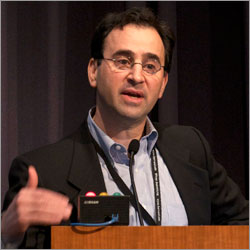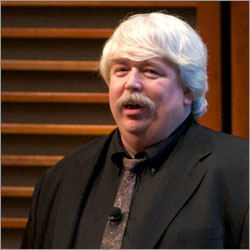From the fluctuations of heartbeats and breaths, to the mechanisms that cause a bee’s wings to flap, to the way that termites work together to air condition their nests, Nature is overflowing with examples of complex, non-linear dynamical systems and behaviors that are often at the edge of chaos. On June 8, leading clinicians, scientists, and academics gathered in Boston’s Longwood Medical Area to explore ways in which the noise and rhythms characteristic of living systems could be harnessed to transform medicine and robotics.

The occasion was the third annual Wyss Institute international symposium. This year’s event, Noise and Rhythm: Harnessing Complexity in Medicine and Robotics, drew more than 400 attendees from across the country and from as far away as Japan, China, and Poland.
“The idea that we can leverage noise and variability in biological rhythms to restore control may seem totally counterintuitive to what we have learned,” said Wyss Founding Director Don Ingber. “But as you’ll see today, new insights into how Nature harness noise is beginning to lead to some new paradigm-shifting approaches to all sorts of real-world challenges.”
In addition to Ingber, the conference was organized by Wyss Core Faculty members Jim Collins, Ary Goldberger, Radhika Nagpal, Conor Walsh, and Robert Wood.
The day opened with a look at the body’s nonlinear physiological systems, such as brain activity, heartbeats, and breathing patterns and ways in which knowledge of these patterns could be applied to clinical medicine. Wyss Associate Faculty member Eugene Goldfield served as Chair of this first session in which Associate Faculty member David Paydarfar presented his work on monitoring breathing irregularities among premature infants to identify and, by applying mechanical noise using a vibrating mattress, to avert the dangerous pauses that can be fatal. In the same session, Goldberger stressed that healthy human output signals are complicated and irregular and that it is this level of unpredictability that provides a person with the tools needed to continually adjust to changing conditions. He called this complex variability the “spice of life.”

Focusing on human biomechanics and engineering, Michael Goldfarb, Director of the Center for Intelligent Mechatronics at Vanderbilt University, shared highlights of his cutting-edge assistive devices that could dramatically improve the lives of people with physical disabilities. For instance, a lower-limb prosthesis that is being developed at the Center combines actively powered knee and ankle joints in a self-contained system that allows the user to perform a range of daily activities, including walking up and down hills and stairs, and running on a treadmill. He also showed a movie of in which a related device enabled a paraplegic to walk with only the assistance of two crutches.
Wood chaired a session entitled “Control” in which he described the novel manufacturing process he has invented in which tiny robots can be fabricated using a pop-up process similar to a child’s pop-up book. And Nagpal presented her research developing algorithms for programming many individual robots to work together toward a single goal. Her work is inspired by the behavior of termites, and could one day lead to swarms of autonomous robots that can collaborate to build retaining walls out of sandbags.
In a keynote address that ended the symposium, Robert Full of the University of California, Berkeley, explained how he finds inspiration in the natural mechanical dynamics of cockroaches and geckos. Such living systems can survive head-on collisions, cling to vertical walls, scamper across slippery surfaces, and make abupt 180 degree turns at rates faster than human response times. Full, who is also Founder and Director of Interdisciplinary Bio-inspiration in Education and Research, said that the full potential of the bio-inspired robotics market is just emerging.
Each year, the Wyss Institute international symposium brings together scientific luminaries and thought leaders to explore an area in which new technologies inspired by Nature have the potential to lead to transformative changes. Last year, Microfluidics and Medicine: Accelerating the flow from lab to clinic highlighted the exciting advances — and formidable commercialization challenges — taking place in the rapidly evolving field of microfluidics. In 2010, New Directions in Synthetic Biology focused on research at the leading edge of the Synthetic Biology field, with an emphasis on science-driven technology development relating to medicine, sustainability, ecology, and nanotechnology.